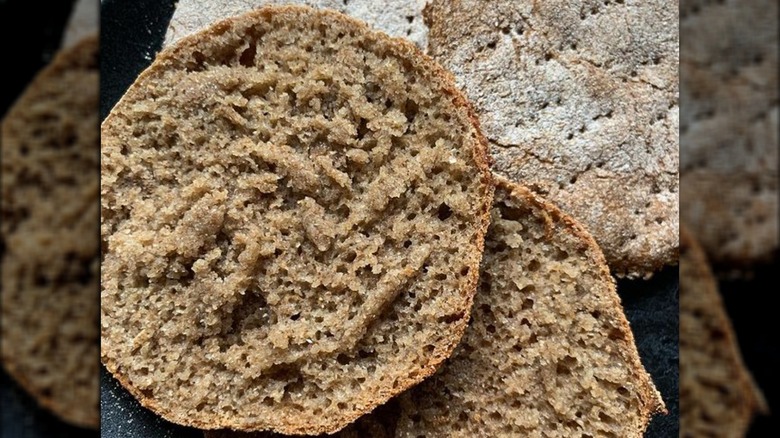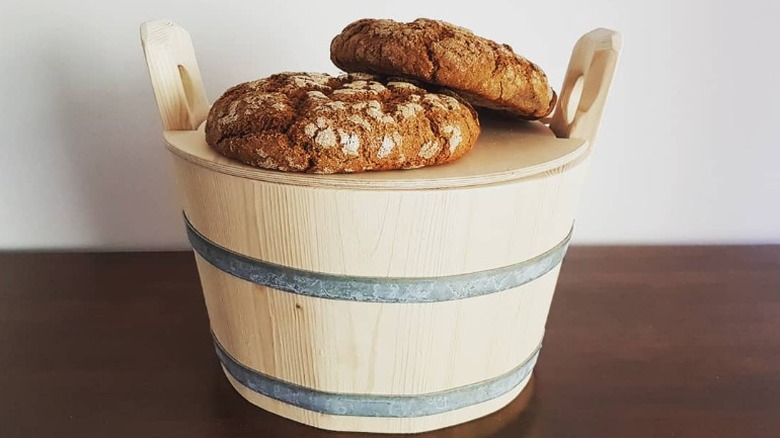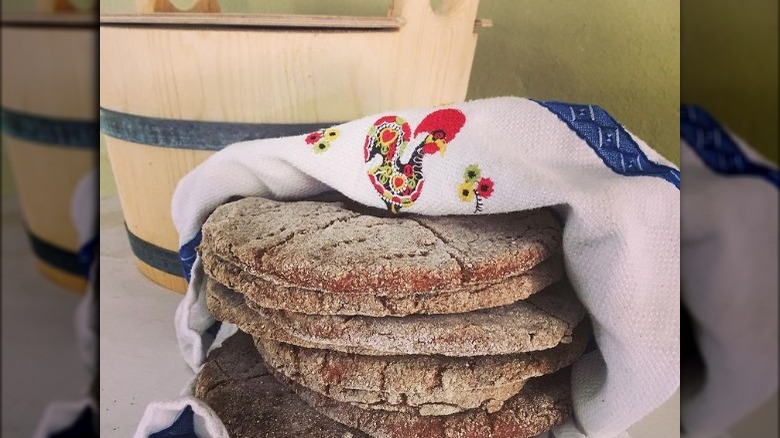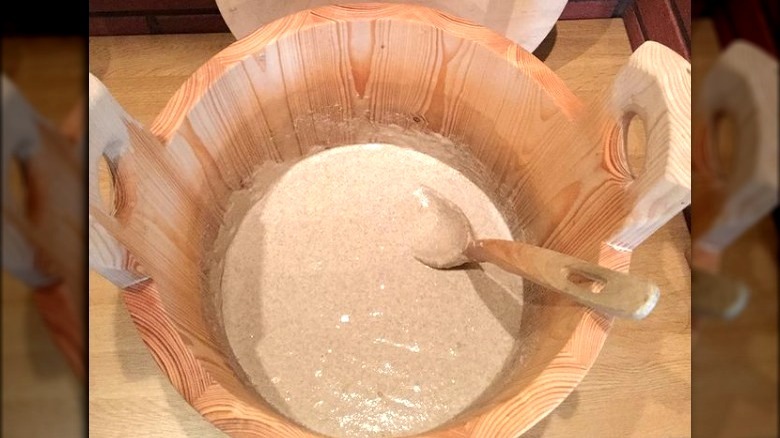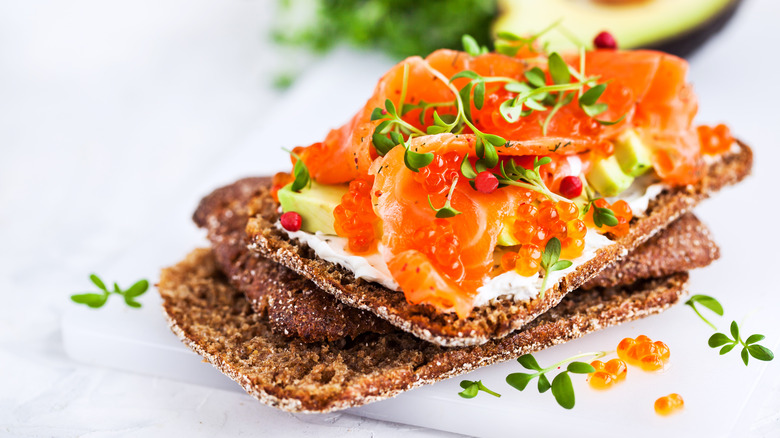Everything You Need To Know About Ruisleipä, Or Finnish Rye Bread
During the 2020 bread baking craze, everyone was making white sourdough. But they missed a great opportunity to make an even tastier, healthier version — Finnish sourdough rye bread, or ruisleipä.
Ruisleipä – which literally translates to rye (ruis) bread (leipä) in Finnish – is a staple in the Finnish diet and was voted Finland's national food in 2017, writes This Is Finland. It's very different from American rye breads, which The Guardian points out are made with only 20% rye. Ruisleipä, on the other hand, is made out of 100% rye flour, writes The Sandwich Tribunal, and has four times more fiber than wheat-based bread, per The Guardian.
Part of the bread's popularity comes from the fact that rye adapted well to growing in Finland's short summer season and cold, harsh winters, and tolerates poor soil conditions. As Johanna Mäkelä, professor of food culture at the University of Helsinki, told This Is Finland, "Finnish rye bread is a story of a poor country, as there were so few ingredients that were always available. Water, leaven, salt and rye flour – that's still the basic recipe." This is Finland notes that what makes it special is the leavening agent, a sourdough starter called leivän juuri in Finnish, or "the root of the bread," which is often passed down over generations. However, My Vintage Cooking writes that you can make your own starter from 100% rye flour, ready for baking in approximately 24-36 hours.
Ruisleipä is extremely nutritious
Not only is there additional fiber in rye flour, it's also packed with nutrients. The World's Healthiest Foods writes that because rye flour is tougher to separate from the bran and germ than white flour, it doesn't lose nutrients the way processed wheat flour does. They note that some studies have even shown high fiber foods can help prevent gallstones, decrease the risk of some cancers, and improve cardiovascular health. The Guardian also reports that fiber from rye has been shown in studies in Finland and Sweden to keep blood sugar levels steady, which is especially helpful for diabetics.
According to the Livonsaari Bakery, traditionally the dough was mixed in a wooden bucket called a taikinatiinu, similar to birch buckets used for water in saunas. The wood absorbs some of the natural lactic acid bacteria it produces, helping the sourdough starter activate and rise more rapidly. The little bit of natural fermentation in the starter makes the bucket slightly warm, additionally helping the dough to quicken. These bread buckets are not washed between batches as to retain the natural microbial environment, Sarka writes. Lactic acid bacteria is helpful for digestion, per the British Columbia Dairy Association, and its probiotics have a number of health benefits, such as improved digestion and immune system function.
You can get the health benefits of ruisleipä without a taikinatiinu, but many Finnish craft bakeries like Livonsaari still use the authentic methods. Finnish magazine Kotiliesi also notes the microbes act as a natural preservative, increasing its shelf life.
Sourdough starter and the right flour make all the difference
To make ruisleipä, you first have to make the sourdough starter, which My Vintage Cooking instructs can take 24-36 hours until it's ready for use. Kotiliesi points out it can take several days to fully ferment if you're starting from scratch, but 12-18 hours if you make it starting from crumbs from an old loaf. They suggest you taste the starter — if it doesn't taste sour enough, leave it for a little bit longer.
Then, you need to track down the proper flour. Rye flour isn't the most common thing you'll see on U.S. grocery shelves, but there are many options available on Amazon. In particular, Bob's Red Mill also makes 100% Dark Rye Stone Ground Flour, and King Arthur Flour makes a 100% Organic Medium Rye. The dark rye will provide a more authentic deep brown color, but the medium would work too. The main thing is to make sure it's 100% rye flour — for authentic ruisleipä you'll want to stay away from flour blends. You can mix different 100% rye flours to change the flavor, but that stoneground rye provides a nice course texture and flavor.
Making ruisleipä requires some patience
Once the starter is ready, it's time to mix the ingredients: flour, water, salt, and starter. You'll want to measure accurately to ensure you get the correct ratios. Most authentic recipes use metric measurements, so you can use them or convert them to the US Imperial sizes. This is where patience comes in handy again. Mix the flour and hot water with the starter, then cover it leave it in a warm place for a few hours, ideally overnight.
Next, you'll do a few "feedings" of the starter into the mixture by adding in a little more starter and a little water. The mixture will be runny, like loose oatmeal. After it's rested again for a while, gradually add more flour until it's thick and hard to mix, then let it rest a bit more. You can keep a small bit of the unsalted dough to use as a starter, which will last for up to two weeks in the fridge in an airtight container.
Salt is then added, and the dough is kneaded and left to rise a few more hours. When it's doubled in size, it's shaped into loaves, rested again for a final rise and then baked in a hot oven, around 400 F for 45 to 60 minutes (depending on the size of the loaf), says My Vintage Kitchen. Once it's baked, let it cool a bit before eating. Ruisleipä also freezes well, so you can make large batches and bring them out to thaw and eat later.
Finns eat ruisleipä with everything
One of ruisleipä's primary features is its chewy yet soft texture and slightly sweet-sour flavor. While it is leavened, the bread tends to be flatter, The Sandwich Tribunal explains, because of the chemical compounds in the rye itself, including its naturally low gluten content.
Ruisleipä also comes in a wide variety of shapes. Traditional round, flat loaves called ruisreikäleipä were made with a hole in the middle and hung on a pole in a warm kitchen to dry and age, writes Taste Atlas. It also comes in single-serving sandwich rounds or rectangles, as well as larger round loaves. Iconic Finnish brand Fazer is one of the top commercial producers of rye bread in the country.
There are endless choices of what to eat with your ruisleipä. Unlike American sandwiches with ingredients between two slices of bread, most ruisleipä sandwiches are eaten open-faced, topped with everything from plain butter to cold cuts, cheese, liverwurst, jams, or even reindeer — which Finns eat regularly, writes Visit Finland. There are fancier combinations too, like shrimp, cheese, dill, and cucumber or the classic cured salmon, tomato, cucumber, onion, and dill version.
True ruisleipä is hard to find in the States, though Arctic Swan Bakery in Pennsylvania ships nationwide. Sites carrying Finnish products like FinnGoods occasionally have varieties of Fazer bread in stock, but they usually sell out quickly. But once you get your hands on this unique rye bread, you'll see it was worth the effort.
